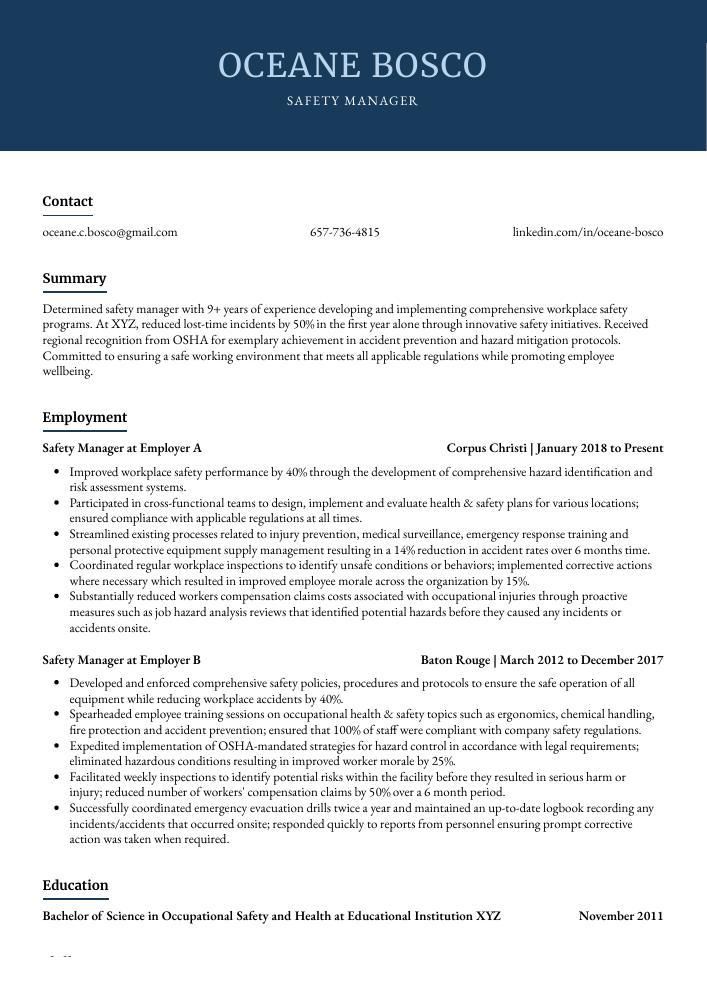Safety Manager Resume Guide
Safety Managers are responsible for developing and implementing safety policies, procedures and systems to protect employees from workplace hazards. They inspect facilities to identify potential risks, analyze accidents or incidents that have occurred in the past, develop safety plans with corrective actions, provide training on safe work practices and monitor compliance with applicable laws.
You have the expertise to protect any workplace and keep it compliant with safety regulations. To get employers to recognize your qualifications, you must write a resume that highlights your experience in the field of safety management.
This guide will walk you through the entire process of creating a top-notch resume. We first show you a complete example and then break down what each resume section should look like.
Table of Contents
The guide is divided into sections for your convenience. You can read it from beginning to end or use the table of contents below to jump to a specific part.
Safety Manager Resume Sample
Oceane Bosco
Safety Manager
[email protected]
657-736-4815
linkedin.com/in/oceane-bosco
Summary
Determined safety manager with 9+ years of experience developing and implementing comprehensive workplace safety programs. At XYZ, reduced lost-time incidents by 50% in the first year alone through innovative safety initiatives. Received regional recognition from OSHA for exemplary achievement in accident prevention and hazard mitigation protocols. Committed to ensuring a safe working environment that meets all applicable regulations while promoting employee wellbeing.
Experience
Safety Manager, Employer A
Corpus Christi, Jan 2018 – Present
- Improved workplace safety performance by 40% through the development of comprehensive hazard identification and risk assessment systems.
- Participated in cross-functional teams to design, implement and evaluate health & safety plans for various locations; ensured compliance with applicable regulations at all times.
- Streamlined existing processes related to injury prevention, medical surveillance, emergency response training and personal protective equipment supply management resulting in a 14% reduction in accident rates over 6 months time.
- Coordinated regular workplace inspections to identify unsafe conditions or behaviors; implemented corrective actions where necessary which resulted in improved employee morale across the organization by 15%.
- Substantially reduced workers compensation claims costs associated with occupational injuries through proactive measures such as job hazard analysis reviews that identified potential hazards before they caused any incidents or accidents onsite.
Safety Manager, Employer B
Baton Rouge, Mar 2012 – Dec 2017
- Developed and enforced comprehensive safety policies, procedures and protocols to ensure the safe operation of all equipment while reducing workplace accidents by 40%.
- Spearheaded employee training sessions on occupational health & safety topics such as ergonomics, chemical handling, fire protection and accident prevention; ensured that 100% of staff were compliant with company safety regulations.
- Expedited implementation of OSHA-mandated strategies for hazard control in accordance with legal requirements; eliminated hazardous conditions resulting in improved worker morale by 25%.
- Facilitated weekly inspections to identify potential risks within the facility before they resulted in serious harm or injury; reduced number of workers’ compensation claims by 50% over a 6 month period.
- Successfully coordinated emergency evacuation drills twice a year and maintained an up-to-date logbook recording any incidents/accidents that occurred onsite; responded quickly to reports from personnel ensuring prompt corrective action was taken when required.
Skills
- Safety Management Systems
- Construction Safety
- Occupational Health
- Inspection
- Industrial Safety
- Accident Investigation
- Supervisory Skills
- Risk Assessment
- Workplace Safety
Education
Bachelor of Science in Occupational Safety and Health
Educational Institution XYZ
Nov 2011
Certifications
Certified Safety Manager
Board of Certified Safety Professionals
May 2017
1. Summary / Objective
A resume summary/objective should be a concise overview of your qualifications and experience as a safety manager. In this section, you could mention the OSHA certifications you have obtained, the number of years’ experience in safety management that you possess, and any successful initiatives or projects that demonstrate your expertise in creating safe working environments.
Below are some resume summary examples:
Hard-working safety manager with 10+ years of experience in developing and implementing effective safety programs. Experienced in conducting regular inspections to ensure compliance with OSHA standards, providing comprehensive hazard assessments, and establishing emergency plans. At XYZ Corporation, successfully reduced workplace injuries by 25% over a three-year period. Proven track record for creating safe work environments that foster productivity and morale.
Seasoned safety manager with 7+ years of experience in workplace safety planning and implementation. Proven track record of mitigating risks, creating hazard control plans, training personnel on best practices for job site safety, developing emergency action plans, and conducting internal audits. Seeking to use my expertise to ensure the health and wellbeing of ABC’s workforce while meeting all regulatory compliance requirements.
Driven safety manager with 8+ years of experience in the construction industry. Expertise in developing and implementing effective health and safety strategies to reduce incidents, improve operations, and ensure compliance with all relevant regulations. At XYZ Construction successfully reduced workplace accidents by 25% within a 12-month period. Seeking an opportunity to utilize my skills at ABC Corp as the Safety Manager.
Skilled safety manager with over 10 years of experience in developing and implementing safety protocols for various industries. Skilled at creating an incident-free workplace environment by identifying risks, establishing preventive measures, and providing training to employees on safe practices. At XYZ company, reduced the number of accidents by 30% within six months through proactive risk management strategies.
Well-rounded safety manager with 7+ years of experience managing safety protocols, workplace compliance standards, and risk management for medium-sized organizations. Seeking to join ABC Company to promote a safe work environment through effective communication and timely incident reporting. During my tenure at XYZ Inc., implemented proactive measures that reduced the rate of workplace injuries by 32%.
Detail-oriented Safety Manager with 7+ years of experience developing and implementing safety protocols. Looking to join ABC Company, where I can use my industry knowledge to ensure the well-being of all employees while maintaining a safe workplace environment. At XYZ Corp., developed an extensive safety program that resulted in a 33% reduction in workplace injuries over three years.
Talented Safety Manager with 7+ years of experience leading safety initiatives for diverse industries. At XYZ Company, reduced workplace incidents by 33% and improved overall compliance ratings from 80 to 95%. Seeking a leadership role at ABC Tech that will allow me to leverage my deep understanding of safety regulations, training processes, and risk management procedures.
Accomplished safety manager with 10+ years of experience in the manufacturing sector. Highly knowledgeable in OSHA regulations and creating/implementing safety plans to prevent accidents/injuries while minimizing disruptions to production. At XYZ, reduced worker compensation claims by 65% through improved training programs and heightened awareness amongst staff members.
2. Experience / Employment
The work history/experience section is where you talk about your employment history. It should be written in reverse chronological order, meaning the most recent job goes first.
Stick to bullet points when describing what you did; this makes it easier for the reader to take in all of your information quickly and efficiently. When writing each point, make sure to provide detail on what you did as well as any results that were achieved due to your work.
For example, instead of saying “Ensured safety protocols are followed,” try something like this: “Developed a comprehensive safety protocol manual which resulted in a 10% reduction in workplace injuries over 6 months.”
To write effective bullet points, begin with a strong verb or adverb. Industry specific verbs to use are:
Other general verbs you can use are:
- Achieved
- Advised
- Assessed
- Compiled
- Coordinated
- Demonstrated
- Developed
- Expedited
- Facilitated
- Formulated
- Improved
- Introduced
- Mentored
- Optimized
- Participated
- Prepared
- Presented
- Reduced
- Reorganized
- Represented
- Revised
- Spearheaded
- Streamlined
- Structured
- Utilized
Below are some example bullet points:
- Formulated and implemented safety protocols, policies and procedures to reduce workplace hazards by 30%, resulting in a decrease of insurance premiums by $15,000.
- Achieved full OSHA compliance for the company’s operations within 6 months of taking on the role; conducted regular inspections and audits to ensure all rules were followed at all times.
- Presented comprehensive monthly reports on safety performance metrics such as near misses and incidents rates, absenteeism trends due to illness/injury etc., enabling prompt corrective actions when needed.
- Meticulously tracked employee training records for more than 200 employees across multiple sites; identified discrepancies promptly and ensured timely refresher trainings were completed each year as required.
- Revised existing emergency evacuation plans annually based on staff feedback & latest industry best practices; coordinated exercises with local authorities every quarter to evaluate effectiveness of these plans in real-world scenarios.
- Optimized safety procedures and guidelines by creating a company-wide training program that decreased employee injury rates by 12%.
- Compiled an extensive list of potential workplace hazards, identified key areas for improvement and designed new protocols to reduce risk in the workspace.
- Structured daily meetings with team members to review safety policies and ensure compliance; created detailed reports on violations & recommended solutions for corrective action when needed.
- Actively monitored hazardous materials storage areas, implemented safe handling processes for dangerous chemicals and ensured all staff had access to personal protective equipment (PPE).
- Reduced overall occupational injuries from 45 cases per month to 15 through proactive inspections, regular maintenance checks on machinery, targeted employee education initiatives & other preventative measures taken throughout the year.
- Mentored and trained a team of 20 safety officers to comply with state and federal regulations, resulting in an 85% reduction in workplace accidents.
- Resourcefully identified potential risks within the organization’s premises and implemented precautionary measures that reduced hazardous situations by 50%.
- Introduced new safety protocols such as weekly inspections, drills for emergency preparedness and regular maintenance checks; decreased insurance premiums by 25%.
- Represented the company at industry conferences & events related to health & safety management, expanding professional network contacts by 30%.
- Reorganized risk management processes from manual operations into automated systems; saved 600+ hours per year while achieving 99% compliance with OH&S standards.
- Utilized industry best practices to develop and implement safety policies, procedures, and regulations that improved overall plant safety by 40%.
- Prepared monthly reports on hazardous materials usage in the facility; identified chemical hazards which resulted in a 20% reduction of accidental exposures to workers.
- Demonstrated strong leadership skills while training employees on proper machine handling techniques; raised awareness of occupational health risks among 100+ staff members.
- Reliably conducted workplace hazard assessments that enabled proactive identification of potential safety issues within the organization resulting in an average 10% decrease in incident rates over two years period.
- Assessed all new equipment for compliance with OSHA standards prior to installations; ensured adherence with federal regulations at all times throughout operations which led to achieving 99% pass rate during inspections from regulatory bodies.
3. Skills
Skill requirements will differ from employer to employer – this can easily be determined via the job advert. Organization ABC might require experience with OSHA regulations, while Organization XYZ may need someone who is an expert in fire safety.
Therefore, it is essential to tailor the skills section of your resume to each job that you are applying for. This will ensure that applicant tracking systems (ATS) recognize your qualifications and pass on your application to a human recruiter.
In addition to listing relevant skills here, consider elaborating on them further in other sections such as the summary or experience section.
Below is a list of common skills & terms:
- Accident Investigation
- Auditing
- Behavior Based Safety
- Construction Management
- Construction Safety
- Continuous Improvement
- Contract Management
- Contract Negotiation
- Contractors
- EHS
- Emergency Management
- Energy
- Engineering
- Environmental Awareness
- Environmental Compliance
- Environmental Management Systems
- Ergonomics
- Fall Protection
- Fire Safety
- First Aid
- Gas
- HAZWOPER
- Hazard Analysis
- Hazard Identification
- Hazard Recognition
- Hazardous Materials
- Hazardous Waste Management
- ISO 14001
- Incident Investigation
- Industrial Hygiene
- Industrial Safety
- Inspection
- Lean Manufacturing
- Logistics
- Manufacturing
- OSHA 30 Hour
- Occupational Health
- Operations Management
- Petroleum
- Policy
- Pre Construction
- Process Improvement
- Process Safety
- Process Scheduler
- Program Management
- Project Planning
- Risk Assessment
- Risk Management
- Root Cause Analysis
- Safety Auditing
- Safety Management Systems
- Safety Training
- Subcontracting
- Supervisory Skills
- Team Leadership
- Transportation
- Workplace Safety
4. Education
Adding an education section to your resume will depend on how far along you are in your career. If you’ve just graduated and have little to no work experience, include an education section below your resume objective. However, if you have a few years of experience working as a safety manager, it might be better to omit the education section altogether so that more focus can be placed on relevant job experiences.
If including an education section is necessary for your particular situation, make sure to list courses or subjects related to safety management that could give potential employers insight into why they should hire you over other candidates.
Bachelor of Science in Occupational Safety and Health
Educational Institution XYZ
Nov 2011
5. Certifications
Certifications are a great way to demonstrate your knowledge and proficiency in a certain field. They can be especially useful when applying for jobs that require specific skills or qualifications.
Including certifications on your resume is an excellent way to show potential employers that you have the necessary expertise, as well as having kept up with industry trends and developments. Make sure to list any relevant certifications you hold so they don’t go unnoticed!
Certified Safety Manager
Board of Certified Safety Professionals
May 2017
6. Contact Info
Your name should be the first thing a reader sees when viewing your resume, so ensure its positioning is prominent. Your phone number should be written in the most commonly used format in your country/city/state, and your email address should be professional.
You can also choose to include a link to your LinkedIn profile, personal website, or other online platforms relevant to your industry.
Finally, name your resume file appropriately to help hiring managers; for Oceane Bosco, this would be Oceane-Bosco-resume.pdf or Oceane-Bosco-resume.docx.
7. Cover Letter
Submitting a cover letter with your job application is a great way to show the employer that you are an ideal candidate for the role. It should be made up of 2 to 4 paragraphs and provide additional information about yourself, such as why you’re passionate about working in that particular industry or how your skills can add value to their organisation.
Cover letters aren’t always required when applying for jobs but it’s recommended that you write one anyways. They offer recruiters a chance to get know who you are on a deeper level and gain better insights into what makes you unique from other applicants.
Below is an example cover letter:
Dear Madie,
I am interested in the Safety Manager position at XYZ Corporation. With more than 10 years of experience managing safety programs in the construction industry, I am confident I would be a valuable asset to your team.
In my current role as Safety Manager at ABC Construction, I oversee all safety initiatives for a team of 100+ employees. I have developed and implemented successful safety programs that have reduced on-the-job injuries by 25% over the past two years. My experience has also taught me how to effectively investigate accidents, identify root causes, and develop corrective action plans to prevent future incidents.
I am passionate about promoting safe work practices and protecting employees from preventable injuries. I am knowledgeable of OSHA regulations and best practices for construction site safety. My excellent communication and interpersonal skills allow me to build relationships with employees at all levels and across departments, which is essential for developing a culture of safety within an organization.
I am confident that I can bring my knowledge and experience to XYZ Corporation and make a positive impact on your team’s safety program. Thank you for your time, and I look forward to speaking with you soon about this opportunity.
Sincerely,
Oceane
Safety Manager Resume Templates
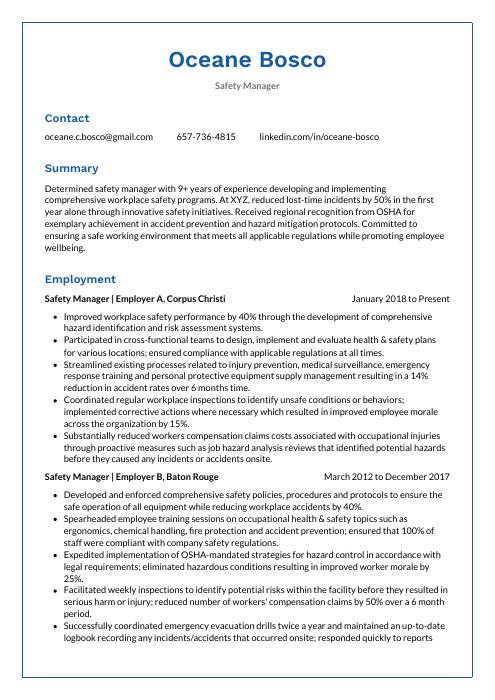 Markhor
Markhor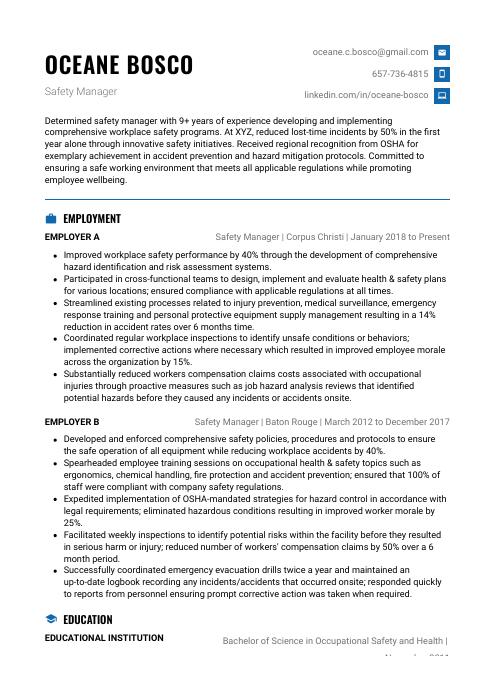 Echidna
Echidna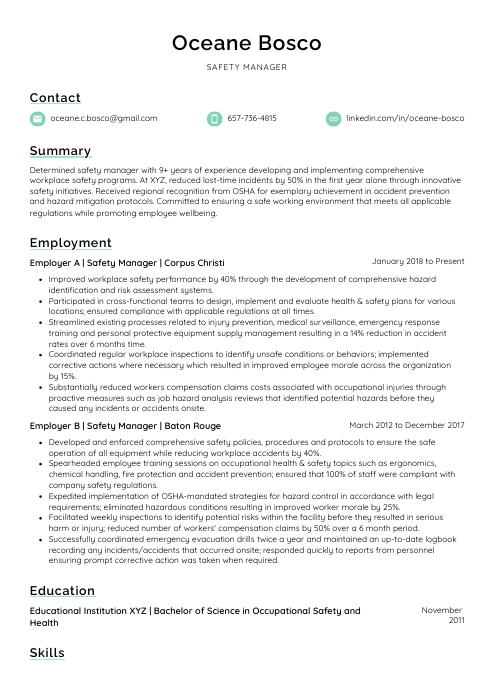 Lorikeet
Lorikeet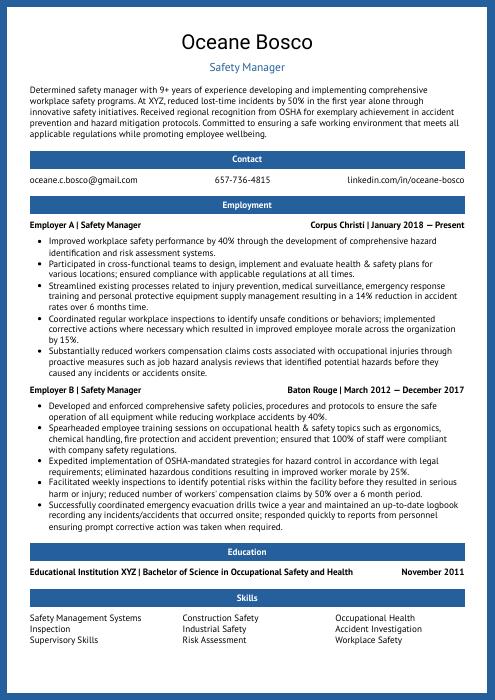 Ocelot
Ocelot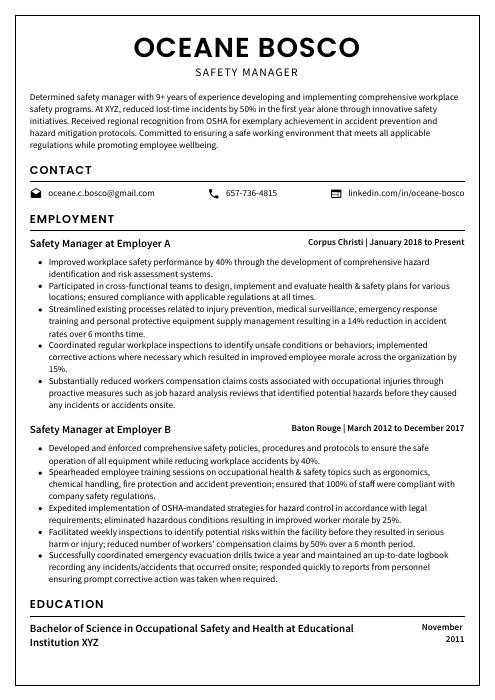 Cormorant
Cormorant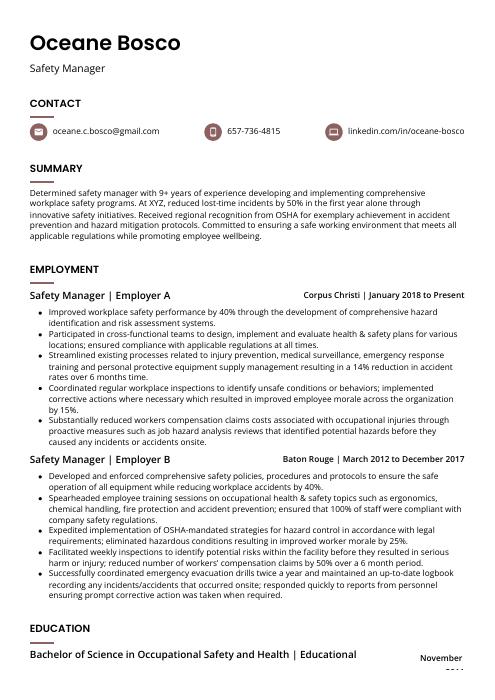 Fossa
Fossa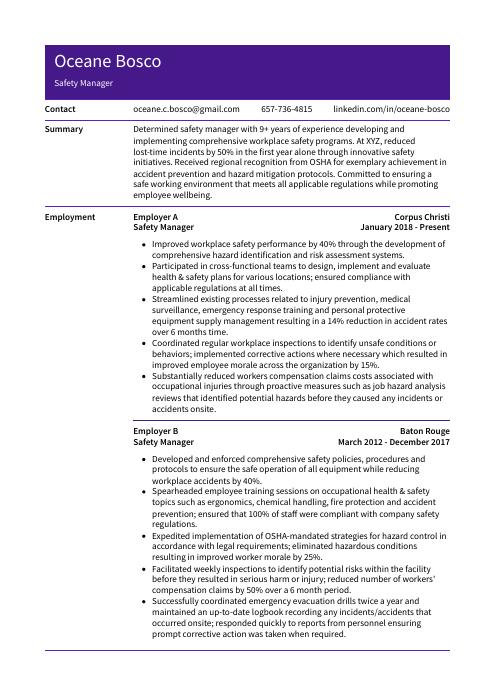 Pika
Pika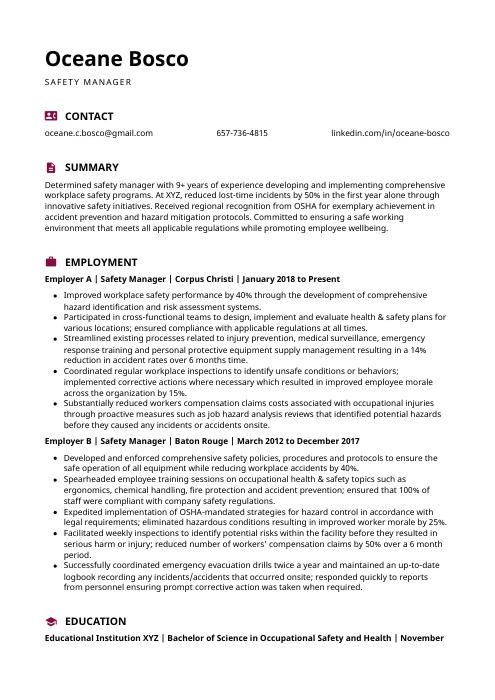 Hoopoe
Hoopoe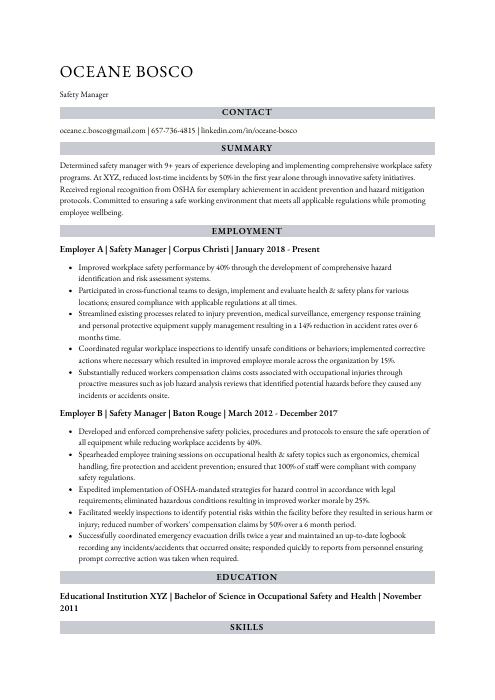 Numbat
Numbat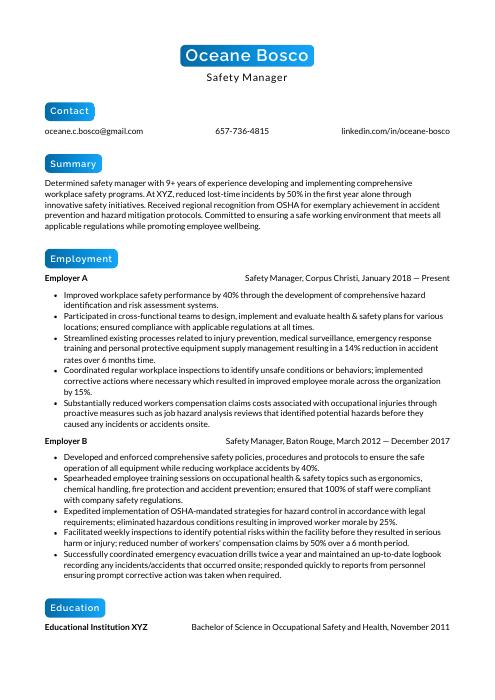 Kinkajou
Kinkajou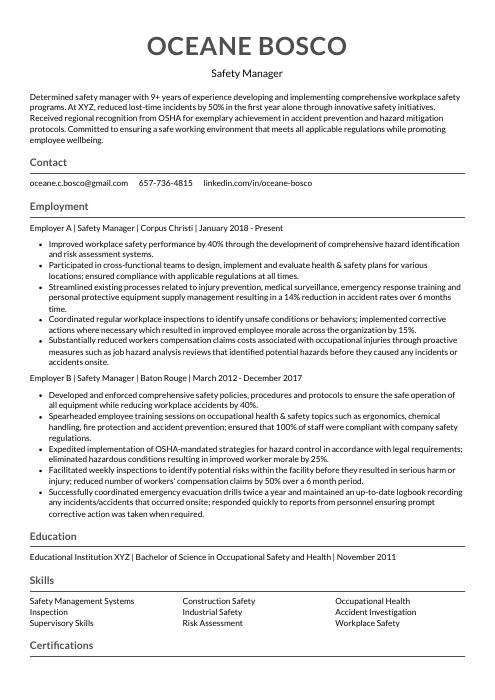 Indri
Indri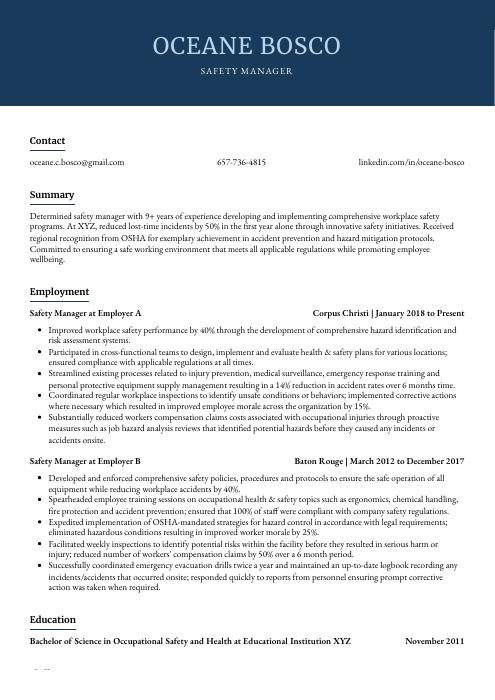 Bonobo
Bonobo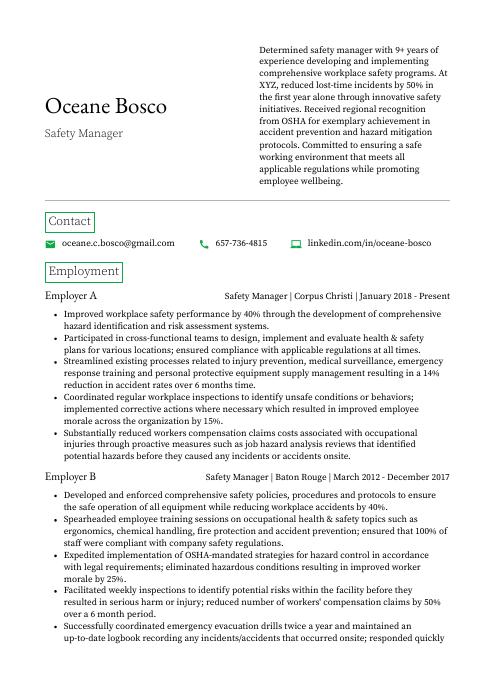 Quokka
Quokka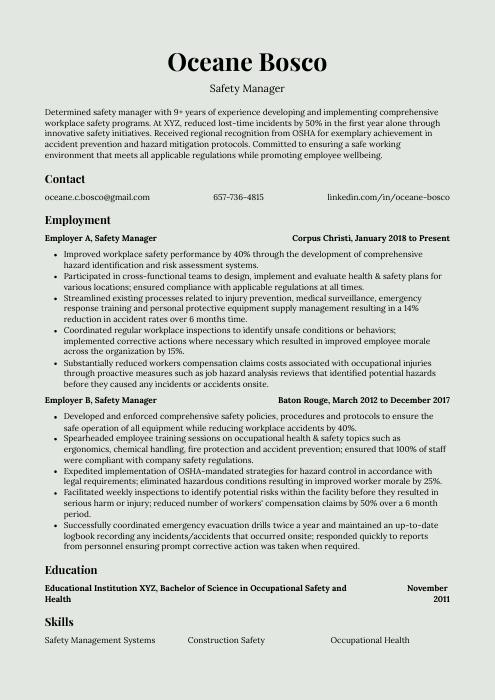 Saola
Saola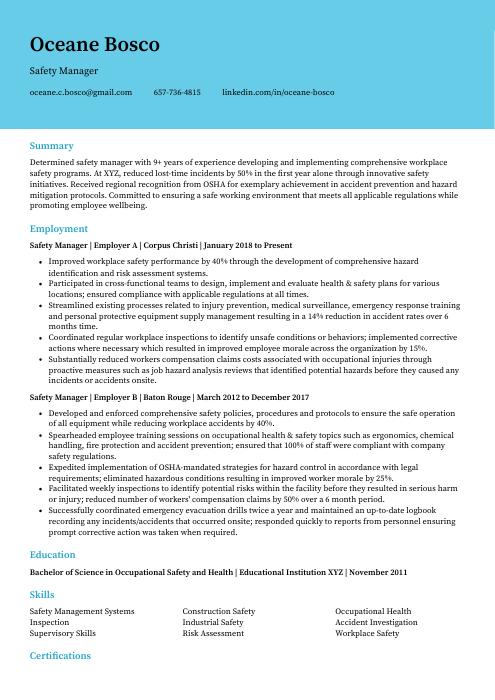 Dugong
Dugong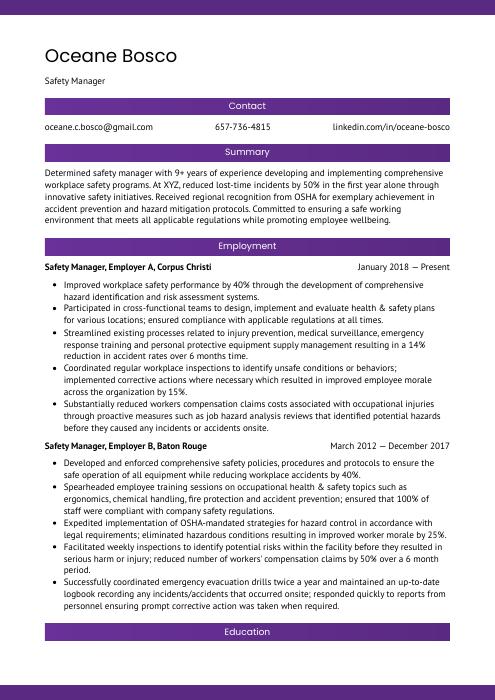 Jerboa
Jerboa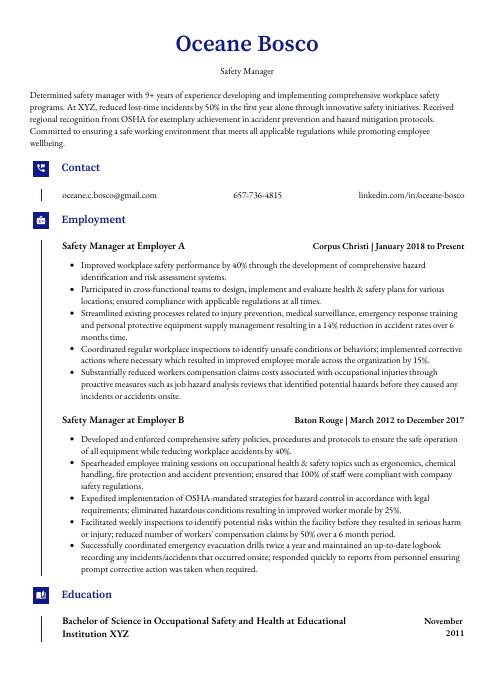 Gharial
Gharial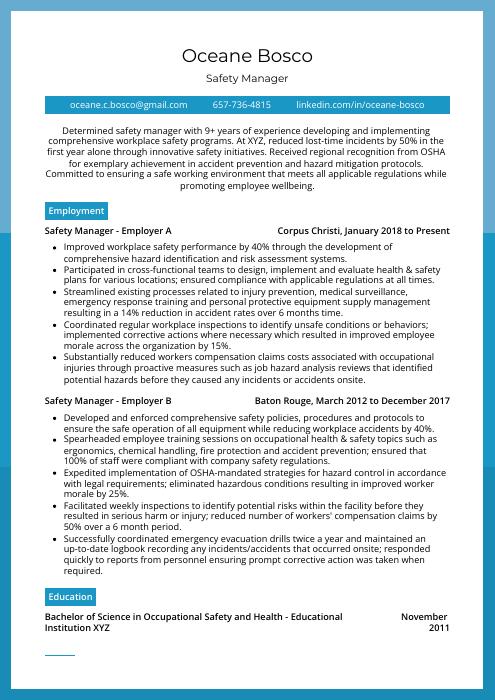 Rhea
Rhea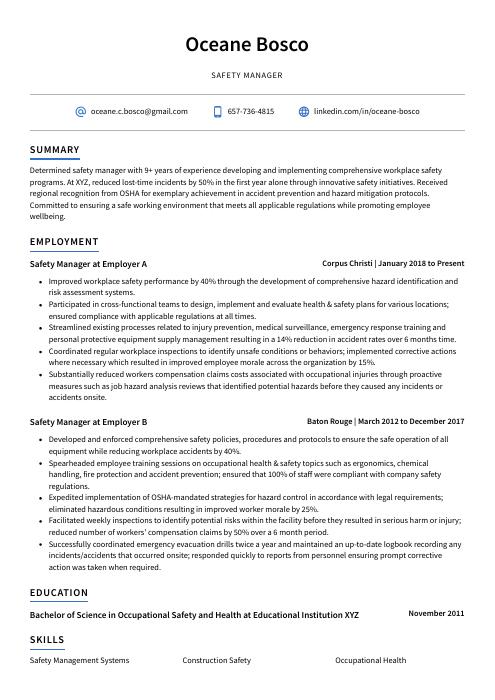 Axolotl
Axolotl Rezjumei
Rezjumei
